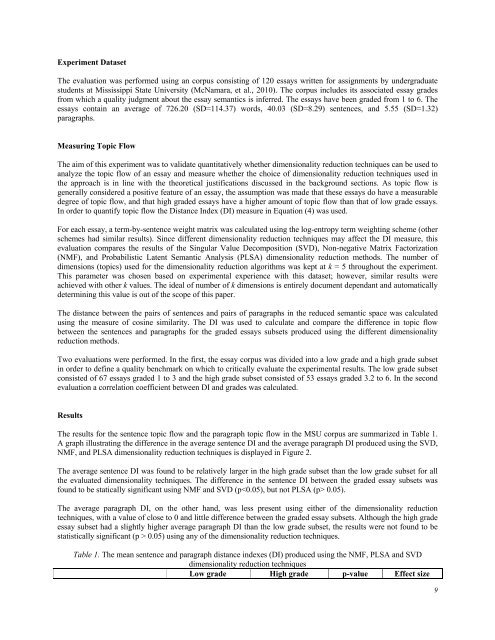Visualizing Topic Flow in Students' Essays - Educational ...
Visualizing Topic Flow in Students' Essays - Educational ...
Visualizing Topic Flow in Students' Essays - Educational ...
You also want an ePaper? Increase the reach of your titles
YUMPU automatically turns print PDFs into web optimized ePapers that Google loves.
Experiment Dataset<br />
The evaluation was performed us<strong>in</strong>g an corpus consist<strong>in</strong>g of 120 essays written for assignments by undergraduate<br />
students at Mississippi State University (McNamara, et al., 2010). The corpus <strong>in</strong>cludes its associated essay grades<br />
from which a quality judgment about the essay semantics is <strong>in</strong>ferred. The essays have been graded from 1 to 6. The<br />
essays conta<strong>in</strong> an average of 726.20 (SD=114.37) words, 40.03 (SD=8.29) sentences, and 5.55 (SD=1.32)<br />
paragraphs.<br />
Measur<strong>in</strong>g <strong>Topic</strong> <strong>Flow</strong><br />
The aim of this experiment was to validate quantitatively whether dimensionality reduction techniques can be used to<br />
analyze the topic flow of an essay and measure whether the choice of dimensionality reduction techniques used <strong>in</strong><br />
the approach is <strong>in</strong> l<strong>in</strong>e with the theoretical justifications discussed <strong>in</strong> the background sections. As topic flow is<br />
generally considered a positive feature of an essay, the assumption was made that these essays do have a measurable<br />
degree of topic flow, and that high graded essays have a higher amount of topic flow than that of low grade essays.<br />
In order to quantify topic flow the Distance Index (DI) measure <strong>in</strong> Equation (4) was used.<br />
For each essay, a term-by-sentence weight matrix was calculated us<strong>in</strong>g the log-entropy term weight<strong>in</strong>g scheme (other<br />
schemes had similar results). S<strong>in</strong>ce different dimensionality reduction techniques may affect the DI measure, this<br />
evaluation compares the results of the S<strong>in</strong>gular Value Decomposition (SVD), Non-negative Matrix Factorization<br />
(NMF), and Probabilistic Latent Semantic Analysis (PLSA) dimensionality reduction methods. The number of<br />
dimensions (topics) used for the dimensionality reduction algorithms was kept at k = 5 throughout the experiment.<br />
This parameter was chosen based on experimental experience with this dataset; however, similar results were<br />
achieved with other k values. The ideal of number of k dimensions is entirely document dependant and automatically<br />
determ<strong>in</strong><strong>in</strong>g this value is out of the scope of this paper.<br />
The distance between the pairs of sentences and pairs of paragraphs <strong>in</strong> the reduced semantic space was calculated<br />
us<strong>in</strong>g the measure of cos<strong>in</strong>e similarity. The DI was used to calculate and compare the difference <strong>in</strong> topic flow<br />
between the sentences and paragraphs for the graded essays subsets produced us<strong>in</strong>g the different dimensionality<br />
reduction methods.<br />
Two evaluations were performed. In the first, the essay corpus was divided <strong>in</strong>to a low grade and a high grade subset<br />
<strong>in</strong> order to def<strong>in</strong>e a quality benchmark on which to critically evaluate the experimental results. The low grade subset<br />
consisted of 67 essays graded 1 to 3 and the high grade subset consisted of 53 essays graded 3.2 to 6. In the second<br />
evaluation a correlation coefficient between DI and grades was calculated.<br />
Results<br />
The results for the sentence topic flow and the paragraph topic flow <strong>in</strong> the MSU corpus are summarized <strong>in</strong> Table 1.<br />
A graph illustrat<strong>in</strong>g the difference <strong>in</strong> the average sentence DI and the average paragraph DI produced us<strong>in</strong>g the SVD,<br />
NMF, and PLSA dimensionality reduction techniques is displayed <strong>in</strong> Figure 2.<br />
The average sentence DI was found to be relatively larger <strong>in</strong> the high grade subset than the low grade subset for all<br />
the evaluated dimensionality techniques. The difference <strong>in</strong> the sentence DI between the graded essay subsets was<br />
found to be statically significant us<strong>in</strong>g NMF and SVD (p 0.05).<br />
The average paragraph DI, on the other hand, was less present us<strong>in</strong>g either of the dimensionality reduction<br />
techniques, with a value of close to 0 and little difference between the graded essay subsets. Although the high grade<br />
essay subset had a slightly higher average paragraph DI than the low grade subset, the results were not found to be<br />
statistically significant (p > 0.05) us<strong>in</strong>g any of the dimensionality reduction techniques.<br />
Table 1. The mean sentence and paragraph distance <strong>in</strong>dexes (DI) produced us<strong>in</strong>g the NMF, PLSA and SVD<br />
dimensionality reduction techniques<br />
Low grade High grade p-value Effect size<br />
9
















